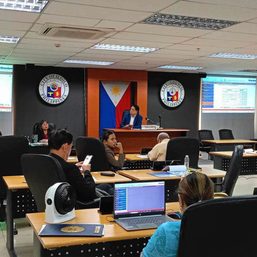SUMMARY
This is AI generated summarization, which may have errors. For context, always refer to the full article.

This compilation was migrated from our archives
Visit the archived version to read the full article.
ILOILO CITY, Philippines – The bike ride to Molo Plaza was only two kilometers away, but traveling that distance turned out to be a longer, two-month road to recovery for biker Wilfredo Sy Jr.
Sy, an architect by profession and an avid cyclist, recalled the crash incident that happened as he was on a nighttime biking tour in May 2016.
As he was about to cross Diversion Road, one of Iloilo City’s major highways, Sy saw a car signaling a left turn. Thinking it was safe to cross, Sy crossed the road – and next thing he knew, he found himself looking up at the stars.
“I fell onto the windshield, I rolled down onto the hood, down to the ground. The bike I was riding had twisted,” Sy narrated.
Fortunately for him, the crash was not serious enough to leave him with major injuries. His X-ray results showed that his neck had straightened out a little, and the incident left him limping for two months.
But Sy admits that he nearly had a close call.
“I wasn’t even planning on wearing my helmet, but eventually I decided to wear one since everyone else in my group was wearing a helmet,” he said.
Since the crash, Sy said he had become more cautious when setting out on his weekly bike rides around the city hailed as one of the most walk-friendly and bike-friendly places in the Philippines.
With a 5-kilometer stretch of bicycle and pedestrian lane along one of its major highways, Iloilo City has made a name for itself in providing alternative mobility infrastructure for pedestrians and cyclists.
Despite these provisions for some of the most vulnerable road users, this bustling hub in Western Visayas has also racked up a number of road crashes.
According to 2014 data from the Philippine Statistics Authority, 733 people died from road crash incidents in Region VI.
If population is taken into account, Western Visayas is the most affected region in the island of Visayas in terms of road crash deaths. (READ: IN NUMBERS: Road crash incidents in the Philippines)
Nearly 5,000 crashes
The province of Iloilo, home to 1.81 million people, recorded 4,877 road crash incidents in the first half of the year, according to data from the Iloilo Provincial Police Office (IPPO) and the Iloilo City Police Office – Traffic Investigation and Enforcement Unit (ICPO-TIEU).
Data from the IPPO showed there were 1,871 road crash incidents from January to July 3, 2017 in the cities and municipalities of the province, excluding Iloilo City.
The bulk of these incidents – 949 cases – resulted in physical injury, while 857 cases resulted in damage to property and 65 were homicide.
The hotspots in the region include the town of Pavia and the roads around Iloilo City and the Iloilo International Airport, particularly on Diversion Road.
The town of Pavia covers around 7 kilometers of the national highway, and around 40,000 people travel through the town daily, according to a study of the Department of Public Works and Highways.
Meanwhile, there were 3,006 road crash incidents in Iloilo City alone from January to June 2017, according to data from the ICPO-TIEU.
Nearly 85% of these cases – 2,540 incidents – resulted in damage to property, while 457 incidents resulted in physical injuries and 9 were homicide cases.
Human error remains the top cause of road crashes. Based on ICPO’s records, there were 2,529 road crash incidents in the 6 districts of the city that were caused by driver error.
“Driver error” covers those who are caught making reckless turns while driving, or those who fall asleep behind the wheel, among others.
Driving under the influence of alcohol is the second top cause of road crashes, with 158 incidents recorded.
Among Iloilo City’s districts, the district of Jaro – the largest in the city, covering 42 barangays – recorded the most number of road crashes with 769 incidents, followed by City Proper with 740 incidents.
//Of the road crash incidents recorded in the city, 2,308 incidents involved vehicles hitting other vehicles, while 449 cases involved vehicles hitting persons.
A problem of enforcement and education
The task of preventing vehicular crashes in Iloilo is a shared responsibility between road users and local government officials.
In Iloilo City, the ICPO and the Transportation Management and Traffic Regulation Office (TMTRO) are in charge of enforcing road rules and regulations. On the region’s highways, it’s the job of the Philippine National Police – Highway Patrol Group (PNP-HPG).
Jun Batillo of the PNP-HPG emphasizes 3E’s in road safety: engineering, or the design of roads; enforcement of road rules and regulations; and education, or spreading awareness on road safety.
But of these, Batillo believes education and enforcement are the two most important factors.
Many of the car and motorcycle drivers the PNP-HPG apprehends, he said, either do not have drivers’ licenses or are using student permits, thinking that they are valid driving licenses.
This misinformation poses a risk to other motorists, since those who drive without the proper licenses presumably do not know the rules on the road.
“Education should start in the issuance of the license. Drivers should have proper training, they should be properly educated that a student permit is not a driver’s license. It’s just a permit to drive while learning to drive,” Batillo said in Filipino.
Enforcing speed limits
Batillo also echoed the ICPO data on what causes most of these road crashes: human error.
But when asked if speeding was also a major concern, he said that it was not as serious a problem as in other places. Roads in Iloilo City, he explained, don't go on for long enough stretches that would allow a motorist to speed.
Yet the city had recently begun – and later suspended – a much publicized crackdown on overspeeding. Two years after a local ordinance was passed prescribing speed limits in Iloilo City’s roads, it was finally implemented in June this year.
The ordinance set a maximum of 60 km/hr on major roads and highways while the minimum speed limit is set at 20 km/h for other roads.
Some questioned this policy, however, pointing out the lack of road signs indicating the new speed limits, as well as the lack of traffic enforcers to implement the ordinance at night.
Add to this the problem of verifying whether motorists had really gone over the speed limit. While the city has speed guns, the PNP-HPG does not have any at all.
Despite this, Batillo gave assurances that the highway police is doing all it can to keep roads safer.
"We don't want people to think that we can't do our jobs because we lack equipment...we're doing all we can to enforce road rules," he said.
The ordinance has since been suspended pending amendments, after proposals to adjust the prescribed speed limits on certain roads. (READ: Long way to go for Iloilo City's speeding ordinance) – with Aika Rey and Michael Bueza / Rappler.com
Learn more about Filipinos' safety on the road by visiting the Road Safety Awareness microsite.
Add a comment
How does this make you feel?
![[Ilonggo Notes] Putting the spotlight on Ilonggo and regional cinema](https://www.rappler.com/tachyon/2024/04/Screenshot-2024-04-07-at-2.04.59-PM.png?resize=257%2C257&crop=321px%2C0px%2C809px%2C809px)




There are no comments yet. Add your comment to start the conversation.